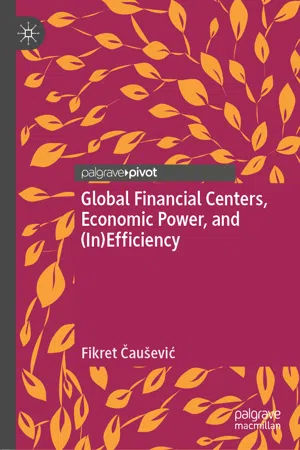This book has been edited by a native English speaker, Desmond Maurer, MA, to whom the author of this book expresses his special thanks.
End AbstractThe first seventeen years of this century have witnessed very intensive, even dramatic changes to the system of global economic and financial power, the global financial architecture, and the role played by the various continents and regions in the formation of global gross domestic product, global financial stocks, and aggregate domestic credit activity. The state of global foreign exchange reserves is a particularly good indicator of how emerging markets’ economic power and export capacities have been transformed. On the eve of the millennium, the advanced countries’ aggregate foreign exchange reserves were 60% greater than those of the rest of the world put together. In the following five years, the emerging market countries increased their exports and official reserves to reach parity with the advanced countries. By the 2010s, the emerging market and developing countries’ share in world official reserves was double that held by the advanced countries.1 This rapid change was spearheaded by China’s rise as an export-led economy, whose manufacturing capacities exploded thanks to major foreign direct investment during the first phase of development, followed by enormous increases in domestic lending.
The rise of the Chinese banking industry was symbolic of the country’s economic rise during these seventeen years. According to The Banker’s Top 1000 World Bank rankings, published by the Financial Times, Chinese banks have held the top four places by total assets and Tier 1 capital base each out of the past four years. In the latest issue (2019), the top four are the ICBC, the China Construction Bank, the Agricultural Bank of China, and the Bank of China. Their combined assets at the end of December 2018 were $13.84 trillion and their combined Tier 1 capital base was $1.098 trillion.2 They were followed by four US banks, namely JPMorgan Chase, the Bank of America, Wells Fargo, and Citigroup. No matter how impressive such rapidly growing banking assets may be as a symbol of China’s rise in financial and economic power, however, they also pose a serious threat to a fast-growing economy. Historical experience, particularly Japan’s with its fast-growing banking sector in the 1980s and the advanced economies during 2002–2008, suggests that rapid banking sector growth, at well above historical or world average rates, tends to end in the host society bearing major costs and suffering serious economic, political, and social distress.
In this book, we will be looking at (i) the concentration of financial stocks, as measured by accumulated assets and liabilities (i.e. the economies’ international investment positions), (ii) economic changes caused by differential rates of economic growth, and (iii) the financial efficiency and sustainability of the present global economic and financial structure. The book has, accordingly, three central chapters. Chapter 2 offers a cross-country analysis of global financial assets and liabilities. Chapter 3 looks at recent changes in the respective roles played by emerging markets and the advanced economies in the creation of world GDP. Finally, Chapter 4 presents a further cross-country analysis of national economic growth rates given major changes in the concentration and availability of financial assets and liabilities and in domestic lending to the non-financial sector. This is followed by a look at the financial efficiency and sustainability of the economic growth models and practices currently favoured in emerging markets and advanced economies.
In 1980, Feldstein and Horioka3 published a paper challenging the neoliberal theoretical assumption that the relationship between domestic savings and domestic investment should not be high in a world of free capital flows, as financial globalization would pave the way for global financial investors to lend money and savings all around the world, driven by their search for higher after-tax returns. What they actually found, however, was a high correlation between domestic savings and domestic investment. The timing was significant in this regard, as they published just two years after China began its officially sanctioned but cautious opening-up with a view to gradual integration into global financial and trade flows. It was also some nine years before the fall of the Berlin wall and the opening up of the so-called communist block (the former socialist or communist countries). These two events would reshape the world of politics and economics on a global scale. The Feldstein-Horioka puzzle was posed afresh by Lucas in a paper in 1990.4 The Lucas paradox highlighted the issue of money failing to flow from advanced to developing countries. These two papers are an important starting point for the analysis in Chapter 2.
Chapter 2 is entitled “Cross-Country Analysis of Global Financial Assets and Liabilities: 2005–2017” and it looks at the accumulated external positions of all the countries for which international investment positions’ data are available. Data availability was a major factor for focusing on 2005–2017. Analysis of the type put forward in this book would not be possible without data for fast-growing highly populated emerging market economies like China, and such data is available only from 2005 on. The main source is International Monetary Fund statistics.5 Analysis of the per capita sum of national assets and liabilities (per capita gross financial stock) shows that the ratio between the twenty top countries (i.e. those with the highest concentration of financial stock) and the twenty poorest economies (i.e. those with the lowest concentration of financial stock) was 2495 to 1 in 2005. By the end of 2010, it was 4015 to 1. By the end of 2017, i...
